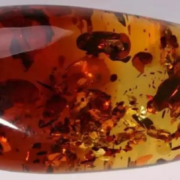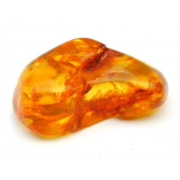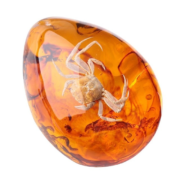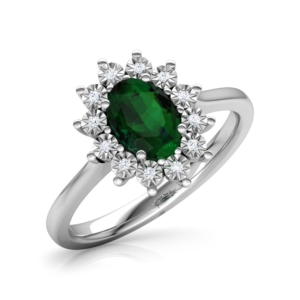Amber Stone – Properties, Virtues & Benefits
Succinestone, also known as Yellow Amber, is an organic gem formed from the fossilized resin of prehistoric trees. It is prized for its natural beauty and healing properties, including soothing aches and pains and stimulating the immune system. Find out more about Succin Stone, its origins and uses.
CHARACTERISTICS OF THE SUCCIN
- Chakra: Solar plexus.
- Properties: Soothing, stimulating, anti-inflammatory, anti-stress.
- Astrology: Sun.
- Zodiac: Leo.
- Elements: Fire.
- Colors: Yellow, gold, orange.
- Hardness: 2-2.5 on the Mohs scale.
- Chemical Formula: C10H16O.
- Associated god: /
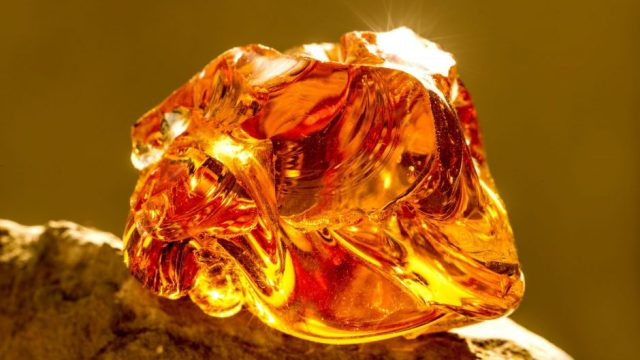
SUCCIN – HIS STORY
DISCOVERING THE SUCCIN
The story of the mineral’s discovery in mineralogy is vague, and even its etymology is uncertain. It is assumed to be derived from the Latin word “succinum”, which means “amber” in French. At the time, it was literally translated as “Baltic amber”, as it was mainly found in this region. However, such stones can now be found in many countries, so this appellation is no longer appropriate. It has also been called karabe and electrum in reference to its energetic charge.
The stone is widely used in the jewelry and decorative industries, and is available in a range of colors from very light white to deep black. It was created over 50 million years ago from the fossil resin of coniferous trees, which can contain insect and plant fossils and air bubbles. This resin can be found on the shores of the Baltic Sea, more specifically in sediments.
Although not officially considered a mineral, the stone is often associated with a gem. It is in fact an organic mineral stone, just like jet, ivory and coral. In the trade, it is often called “yellow amber” because of its luminous, sun-like reflections.
It may be thought that the term “succinum” has an Arabic origin, “anbar”, which has long been used to designate another substance, namely the intestinal concretion of the sperm whale that was used to make perfumes. However, it has nothing to do with succin stone.
In Greek, the precise term for amber is “elektron”, which later gave rise to the word “electricity” in French. Although it may seem strange, there is in fact a link between electricity and amber. The natural resin is thought to have been used as far back as prehistoric times, not only for decoration and jewelry, but also as a raw material for food, just like cereals. Fragments have been found in caves once inhabited by prehistoric tribes, including the Altamira, Magdalenian and Isturitz caves. Today, these simple objects and fragments are invaluable, and are often on display in museums interested in Prehistory.
As early as the 6th century BC, the Celts began to use amber in highly inventive ways, cutting it into beads. This practice continued for centuries and even insPired other cultures across Europe. Amber has also been used for medicinal purposes and as a remedy for various ailments. The ancient Greeks believed amber to have healing properties and used it to treat joint pain and headaches. Similarly, the Romans used it to treat throat ailments.
At the end of the day, amber has a fascinating history and continues to be an object of fascination for many people today. Its natural beauty, rarity and unique properties have ensured its status as a gemstone for thousands of years, and it’s likely to continue to be valued for many years to come.
Succinestone has stimulated trade between civilizations for many centuries, from antiquity to the present day. A trade route was created to transport this stone from one point to another, linking the Baltic Sea directly to the Mediterranean Sea to serve France, Spain, Italy and Greece. The Chinese Hans dynasty knew and used this stone as early as two centuries BC, mainly for medicinal purposes. Succin stone jewelry was also created to take advantage of its lithotherapy benefits, notably to bring eternal youth to the wearer.
In Asia, men wore rings with succin stones to boost their self-confidence, while women might wear stones carved into small animals to increase their fertility. If a woman wore a succin stone bracelet and developed a rash, this was interpreted as evidence of infidelity, which could lead to the death penalty and exclusion from the dynasty. The Scandinavians rather regarded succin stone as the petrified tears of the gods following disappointment or military defeat, and wore succin stone talismans to protect themselves against life’s difficulties.
According to numerous Greek writings, such as those by Pliny the Elder, Aristotle, Homer and Ovid, succin stone is created from poplar and Pine resin. The Egyptians also sought to acquire specimens of this stone using the famous trade route set up for the amber trade. Thus, the succin stone has had a great influence on civilizations around the world, whether in the fields of jewelry, medicine or beliefs.
The Succin is surrounded by many legends in different cultures around the world. In Finnish, it’s called the “sea stone” because it’s found near the salt water of the sea. For the Balts, resin is associated with the goddess Juraté, who was the fiancée of the Water God and lived with him in a palace made entirely of this mineral at the bottom of the sea. According to legend, when she took a human lover, her husband destroyed their palace and killed the lover. Jurate wept with grief and the tears created the Succins. In Greek mythology, the Heliades mourned the death of Helios’ son until the gods of Olympus turned them into poplars. In China, the Succin represents the soul of a dead tiger and is considered a symbol of courage and strength.
The Baltics and Prussians fought over the stone and created strict laws to protect it. Smugglers were severely punished, and one had to negotiate in Königsberg to obtain a natural specimen. Most of the natural reserves are extracted from clay, with an average of 2 kilograms of stone per cubic meter of clay. Every year, around 500 tonnes are harvested, of which only 20% is suitable for jewelry. The rest is used in the chemical industry. Extraction is mainly carried out by quarries in Lithuania.
.
In short, Succin has insPired fascinating legends across different cultures, and its historical and cultural significance as a gemstone continues to fascinate people to this day.
Succin, also known as “Santo Domingo”, originated in the Dominican Republic and was discovered by Christopher Columbus on his second voyage to the East Indies. It is mainly located in the eastern part of the island, in the El Seibo mountain range, at altitudes of up to 1,000 meters and on clay soils that are difficult to access. Due to the lack of technology and the difficult conditions, harvesting is done solely by hand. This variety of Succin is extremely rare and considered the most beautiful, as it is undisturbed by the surrounding flora and fauna.
Before the 1970s, it was necessary to go through traders in Idar-Oberstein to obtain Succin from Santo Domingo, which had to be purchased in raw form. However, these traders often mixed this variety with Baltic Succin. Today, the raw form can no longer leave Dominican territory, and the ore must be worked before being exported. This situation has enabled the island to free itself from traders and develop its own commercial identity.
SUCCIN – ITS ORIGIN AND COMPOSITION
From the first century, it was obvious that Succin was of plant origin, confirmed as observations of the stone progressed. Insects are trapped in the resin, which has hardened, and modern technologies have confirmed that the resins come from conifers from New Zealand and Lebanon, Pines and cypresses from the Baltic. It has recently been discovered that stone can also be produced from the resin of flowering trees and legumes from Mexico and the Dominican Republic. For resin to become stone, pressure, heat, favourable environmental conditions such as the presence of nearby salt water and, above all, time – measured in millions of years – are required.
.
Succin contains succinic acid, a hydrocarbon chain used as an oxidation product. If placed in an organic solvent such as sulfuric ether, the stone will begin to melt at 250 degrees and burn above, releasing a relaxing aromatic scent.
Succin contains between 3 and 8% succinic acid, a tonic that slows cell aging and strengthens the immune system. It also relieves joint pain, teething troubles and resPiratory disorders. Finally, terpenes are also present in the stone, and when heated, muscular aches and pains can disappear.
Fossiliferous Succin is highly prized in the trade and the finest collections can be found in European museums such as the Geological Museum in Copenhagen, but also in those in Königsberg, although part of the collection was destroyed during the war. Insects, animal hairs and plants were probably trapped in the resin due to their attraction to its luminosity, as well as to the winds. Today, resin is considered a good fossilization medium for studying insects and plants. The Succin variety native to Santo Domingo is more fossiliferous than that from the Baltic Sea, with a record 1,200 animals trapped in a single stone.
.
Smaller Succins can be agglomerated thanks to pressure at over 160 degrees, a technique developed in the 1880s that means nothing is wasted during carving. However, the agglomerated Pieces may be visible to the naked eye to a connoisseur, and the color of the pressed resin tends towards brown. It’s important to distinguish the pressed form from the natural form, the latter being found in deposits while the pressed form is man-made. The Germans have specialized in this type of production, and thanks to heat, it is possible to do various things with resin, such as change its color or make it translucent. Resin contains between 3 and 8% succinic acid, a chemical molecule with tonic, immunostimulant and analgesic properties. The terpenes present in the resin can relieve muscular pain.
Succin is found on four continents: Europe, Asia, Oceania and America. The resins found in these areas date back several million years, but the deposits are not all from the same era, as Carboniferous formation did not occur simultaneously in all geographical regions. Although some specimens do not contain fossilized insects, most Succins marketed today come from the Baltic, where the stones are very old, dating back to the Oligocene age. On the other hand, deposits in the Dominican Republic are more recent, dating back “only” 25 million years. There are also other important deposits with different histories.

SUCKIN STONE – VERTIES AND PROPERTIES
PSYCHOLOGICAL SUCCIN
Succin can become magnetic when in direct contact with the skin. For this reason, it is often worn as a necklace or pendant. In contact with the skin, the mineral can become negatively charged and emit negative ions, which can have beneficial effects on health. This electrostatic phenomenon was first observed by Thales, who lived over 600 years ago. Negative ions can help reduce stress and anxiety, boost immune defenses, facilitate sleep and bring a sense of calm. Walks near the beach or a pond can further increase the production of negative ions, leading to a feeling of increased relaxation and calm in Succin stone wearers.
This mineral, known as the Succin stone, has beneficial effects on our body and mind. When in direct contact with our skin, it becomes a magnet and becomes negatively charged, emitting negative ions that have a relaxing effect and strengthen the immune system. In lithotherapy, this stone is said to stimulate the activity of the Sacral chakra, which connects us to our roots and helps us become aware of our value and our good fortune in living in our time. This awareness enables us to rise sPiritually, master our emotions and become mentally stronger and wiser.
Resin can also help the shyest among us to externalize their emotions and develop their personality. It gives physical and mental energy, improves thinking and memory, and enables us to make clear, precise decisions. Its optimistic color encourages us to enjoy life to the full. It can also have beneficial effects on the voice and resPiratory tract, and help young men during moulting.
Succin, or Yellow Amber, is renowned for its healing properties. It is often given to infants to relieve toothache. Similarly, the resin strengthens the immune system and relieves joint problems. The stone’s effects are often instantaneous and noticed by those who use it regularly. However, for the stone to retain its properties, it is important to treat it with care and maintain it properly. We recommend immersing it in cold water with salt once a week, and recharging it by leaving it in the sun for a few hours.

NATURAL SUCCIN STONE – CLEAN AND RECHARGE
Succin Stone is an organic gem that can accumulate negative energies over time. To cleanse and recharge your Succin Stone, here are a few methods:
Cleaning:
- Rinse your succin stone under running water for a few minutes.
- Purify your stone in salt water, then rinse under running water and dry with a soft cloth.
- Smoke your stone with incense or sage to purify it.
Loading:
- Place your succin stone in a bowl of clear quartz or amethyst for several hours or overnight to recharge.
- Expose your succin stone to sunlight for a few hours, preferably in the morning or evening when the sun is less strong.
- Bury your succin stone in soil or sea salt for several hours, then rinse under running water and dry with a soft cloth.
It is recommended to clean and recharge your succin stone regularly to optimize its properties and benefit from its healing virtues.
WHERE DOES THE NAME SUCCIN COME FROM?
The name “Succin” comes from the Latin “succinum”, meaning yellow amber. The name amber comes from the Arabic word “anbar”, which also means amber. Succin is an organic gemstone formed from the fossilized resin of prehistoric trees, and is known for its characteristic golden-yellow color. That’s why it’s also called “yellow amber”.
WHICH CHAKRA DOES THE SUCCIN ACT ON?
Succin acts primarily on the Solar Plexus Chakra (Manipura), which is located in the stomach area. This stone can help balance and stimulate this chakra by boosting self-esteem, confidence and promoting mental clarity. In addition, succin is also known to soothe abdominal pain and digestive disorders that can be linked to an imbalance in the Manipura chakra.
WHICH ASTROLOGICAL SIGN IS ASSOCIATED WITH SUCCIN?
Succin is associated with the astrological sign Leo, which is ruled by the planet Sun. People born under the sign of Leo can benefit from Succin’s properties to boost their self-confidence, creativity and personal radiance. Succin can also help alleviate negative emotions such as anxiety and depression, which can sometimes affect people born under this sign.
SUCCIN STONE SUMMARY
Succinestone, also known as yellow amber, is a fossil resin derived mainly from conifers in the Baltic Sea region. It has been used since ancient times for its medicinal properties and as a raw material for jewelry and objets d’art. Succin stone is also an important source of succinic acid, a compound used in the pharmaceutical and food industries. Because of its beauty, rarity and history, succin stone is also highly prized by collectors and art lovers.
